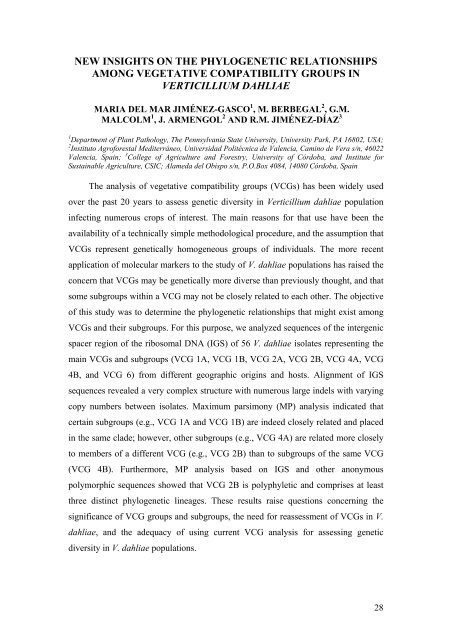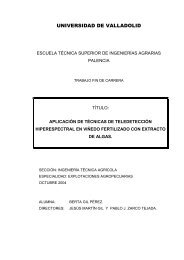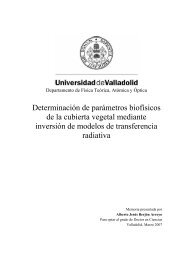10th INTERNATIONAL VERTICILLIUM SYMPOSIUM 16-20 ...
10th INTERNATIONAL VERTICILLIUM SYMPOSIUM 16-20 ...
10th INTERNATIONAL VERTICILLIUM SYMPOSIUM 16-20 ...
Create successful ePaper yourself
Turn your PDF publications into a flip-book with our unique Google optimized e-Paper software.
NEW INSIGHTS ON THE PHYLOGENETIC RELATIONSHIPSAMONG VEGETATIVE COMPATIBILITY GROUPS IN<strong>VERTICILLIUM</strong> DAHLIAEMARIA DEL MAR JIMÉNEZ-GASCO 1 , M. BERBEGAL 2 , G.M.MALCOLM 1 , J. ARMENGOL 2 AND R.M. JIMÉNEZ-DÍAZ 31 Department of Plant Pathology, The Pennsylvania State University, University Park, PA <strong>16</strong>802, USA;2 Instituto Agroforestal Mediterráneo, Universidad Politécnica de Valencia, Camino de Vera s/n, 46022Valencia, Spain; 3 College of Agriculture and Forestry, University of Córdoba, and Institute forSustainable Agriculture, CSIC; Alameda del Obispo s/n, P.O.Box 4084, 14080 Córdoba, SpainThe analysis of vegetative compatibility groups (VCGs) has been widely usedover the past <strong>20</strong> years to assess genetic diversity in Verticillium dahliae populationinfecting numerous crops of interest. The main reasons for that use have been theavailability of a technically simple methodological procedure, and the assumption thatVCGs represent genetically homogeneous groups of individuals. The more recentapplication of molecular markers to the study of V. dahliae populations has raised theconcern that VCGs may be genetically more diverse than previously thought, and thatsome subgroups within a VCG may not be closely related to each other. The objectiveof this study was to determine the phylogenetic relationships that might exist amongVCGs and their subgroups. For this purpose, we analyzed sequences of the intergenicspacer region of the ribosomal DNA (IGS) of 56 V. dahliae isolates representing themain VCGs and subgroups (VCG 1A, VCG 1B, VCG 2A, VCG 2B, VCG 4A, VCG4B, and VCG 6) from different geographic origins and hosts. Alignment of IGSsequences revealed a very complex structure with numerous large indels with varyingcopy numbers between isolates. Maximum parsimony (MP) analysis indicated thatcertain subgroups (e.g., VCG 1A and VCG 1B) are indeed closely related and placedin the same clade; however, other subgroups (e.g., VCG 4A) are related more closelyto members of a different VCG (e.g., VCG 2B) than to subgroups of the same VCG(VCG 4B). Furthermore, MP analysis based on IGS and other anonymouspolymorphic sequences showed that VCG 2B is polyphyletic and comprises at leastthree distinct phylogenetic lineages. These results raise questions concerning thesignificance of VCG groups and subgroups, the need for reassessment of VCGs in V.dahliae, and the adequacy of using current VCG analysis for assessing geneticdiversity in V. dahliae populations.28




